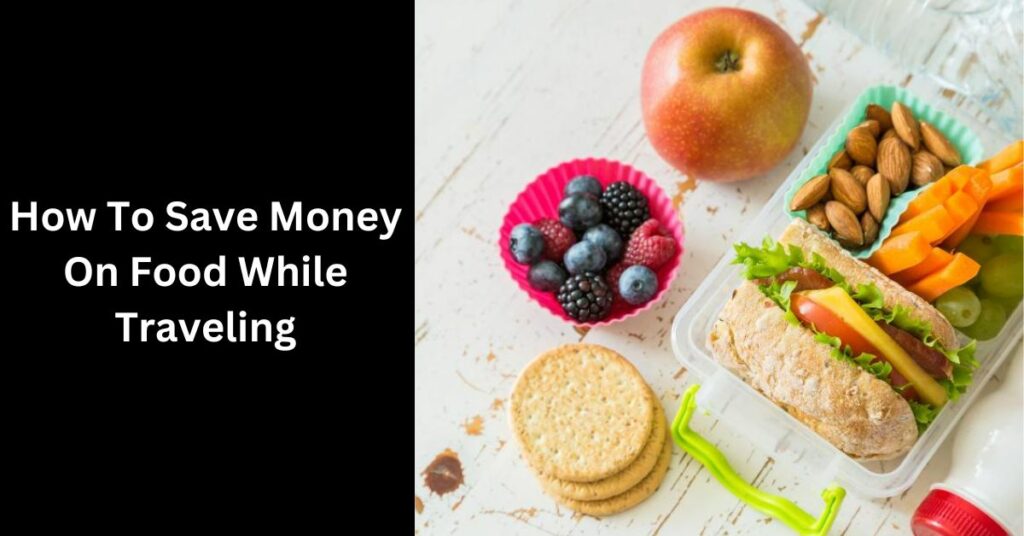As a frequent traveler, I have learned that one of the biggest expenses on any trip is food. Eating out every meal can quickly add up and put a dent in your budget, but it doesn’t have to be that way.
With some planning and creativity, you can save money on food while still enjoying delicious meals and new culinary experiences. In this article, I will share my tips and tricks for how to save money on food while traveling.
From researching local markets to cooking your own meals, there are plenty of ways to cut down on costs without sacrificing taste or adventure. So if you’re ready to eat well without breaking the bank, keep reading!
Research Local Markets and Grocery Stores
You can discover unique and delicious local cuisine by browsing through nearby markets and grocery stores. When traveling, I always make it a point to check out the local markets in the area. It’s an excellent way to explore the local cuisine and cultural food differences.
You’ll find fresh produce, meats, spices, and other ingredients that aren’t just tasty but also budget-friendly. One of my favorite things about visiting these markets is getting to interact with locals who often have insider knowledge on where to get the best deals or which dishes are must-tries. They may even offer cooking tips or recipe ideas that you wouldn’t have thought of before.
Buying ingredients from these places allows you to cook your meals in your accommodation if you have access to a kitchenette or small stove top. Overall, exploring local markets and grocery stores is an exciting and practical way to save money while still experiencing authentic flavors during your travels.
Once you’ve stocked up on ingredients, it’s time for the next step: planning your meals ahead. When planning your meals ahead of time, you can avoid overspending on unnecessary items or eating out at expensive restaurants every day. This doesn’t mean sacrificing taste or variety; instead, it means being intentional about what you buy and how much of it.
In the next section, I’ll share some tips on how to do just that without breaking the bank.
Plan Your Meals Ahead
Planning ahead for your meals can help you make the most of your trip and enjoy delicious, affordable options. Before embarking on a journey, research the local cuisine and plan out meals that fit within your budget.
Meal planning tips include selecting recipes with simple ingredients that can be found at local markets or grocery stores. Creating a meal schedule for each day of the week ensures that you have enough food to last throughout your trip.
Budget-friendly recipes are an excellent way to save money while traveling. Consider easy-to-make dishes like sandwiches, salads, pasta dishes, or stir-fries. These meals require minimal effort and cost less than eating out at restaurants every night. In addition to saving money, cooking your own meals also allows you to control portions and ingredients.
Incorporate local ingredients into your meal plans. Experiment with new spices or herbs that may not be available in your hometown. Not only will this add flavor to your meal, but it will also give you a taste of the local culture.
By planning ahead and creating budget-friendly meals using local ingredients, you can save money on food while enjoying delicious dishes during your travels.
As we wrap up our discussion on planning ahead for meals while traveling, let’s transition into our next topic: cooking our own meals. While meal planning is an excellent way to save money on food during travel, cooking our own meals takes things even further by allowing us complete control over what we eat and how much we spend on groceries.
Cook Your Own Meals
When it comes to saving money on food while traveling, cooking your own meals can be a game changer.
To do this, I recommend utilizing shared kitchens or hostels as they often provide the necessary equipment and space for cooking. Additionally, bringing your own cooking equipment such as a portable stove or pot can save you even more money in the long run.
Utilize Shared Kitchens or Hostels
If you’re staying in a hostel or Airbnb with a shared kitchen, take advantage of it by cooking your own meals and meeting other travelers over dinner. Shared kitchens offer numerous benefits, such as saving money on eating out and the opportunity to try new recipes from different cultures. Hostel cooking tips include bringing your own spices and condiments, buying groceries at local markets, and sharing ingredients with fellow travelers.
During my trip to Europe last summer, I made some amazing meals with new friends in the hostel’s communal kitchen. We shared ingredients and exchanged tips on budget-friendly recipes. Not only did we save money by cooking our own meals, but we also had fun socializing and learning about each other’s backgrounds.
So if you want to save money while traveling and create memorable experiences, make use of shared kitchens or hostels for your meals. Don’t forget to bring your own cooking equipment too! It may be helpful to pack a small set of pots and pans or even just a portable stove for more flexibility in meal options.
Bring Your Own Cooking Equipment
Bringing your own cooking equipment can enhance your hostel experience, allowing for more flexibility in meal options and the ability to create delicious dishes with new friends. Portable options, like a camping stove or a mini grill, can be perfect for cooking meals on-the-go. You can easily whip up breakfast, lunch, or dinner using simple ingredients from local markets or grocery stores. Cooking hacks, like seasoning packets, canned goods, and pre-made sauces, can add flavor to any dish without taking up too much space in your backpack.
Not only does bringing your own cooking equipment save you money on dining out every meal, but it also gives you the opportunity to bond with other travelers over a home-cooked meal. Sharing recipes and culinary experiences is a great way to connect with people from different cultures and backgrounds. Plus, there’s something special about creating a meal together that makes traveling feel even more rewarding.
With all these benefits in mind, why not pack your own portable kitchen gear for your next adventure?
Transitioning into the next subtopic of eating street food without compromising safety is important.
Eat Street Food
Indulging in local street cuisine is like discovering a hidden treasure trove of flavors waiting to be explored. Street food culture is an integral part of any travel experience, and it’s an excellent way to save money on food while traveling.
Not only are you able to taste the local delicacies, but you’re also supporting small businesses that have been nourishing communities for generations. Here are some tips for enjoying street food safely:
- Look for stalls with long lines – they signify popularity and fresh ingredients.
- Observe how the vendor prepares the food – hygiene should always be a priority.
- Follow your instincts – if something doesn’t look or smell right, don’t eat it.
- Bring your own utensils and napkins to avoid using plastic cutlery.
Eating street food can also provide a unique opportunity to immerse yourself in the local culture. You can watch as locals gather around street vendors, sharing stories and laughter over plates of delicious food. It’s an excellent way to meet new people and learn about their way of life.
Incorporating street food into your travel itinerary not only saves you money but also allows you to experience the destination more authentically. So why not step out of your comfort zone and try some new foods? Who knows, you might even discover a new favorite dish! And speaking of trying new things, another great way to save money on meals while traveling is by sharing them with your travel companions.
Share Meals with Travel Companions
Sharing meals with your travel companions is a great way to experience new flavors together and get more out of your dining experience. Not only does it save you money, but it also allows you to try more dishes without feeling too full or guilty about wasting food.
However, there are pros and cons to consider before sharing meals. One advantage is that you can split the bill equally among the group which means saving more money in the long run. You can also order different dishes and share them so that everyone gets a taste of what they like. However, one disadvantage is that not everyone may have the same appetite or dietary restrictions which could cause some conflict when it comes to choosing what to eat.
In terms of etiquette tips, always ask if your companions are comfortable with sharing meals before assuming they’re okay with it. Additionally, be mindful of portion sizes and take turns ordering dishes so that everyone gets a chance to choose something they like. Ultimately, sharing meals with travel companions can be an enjoyable and cost-effective way to dine while on vacation.
By sharing meals with others, you can try new foods together and save money at the same time. However, sometimes tourist traps lure travelers into overpriced restaurants where sharing isn’t an option. In order to avoid these situations, there are some useful strategies that I’ve found helpful during my travels.
Avoid Tourist Traps
If you want to truly experience the local cuisine and avoid overpriced restaurants, it’s important to steer clear of tourist traps. These traps are often located in popular tourist areas, where prices can be marked up significantly.
Instead, venture out into the less crowded parts of town and explore the local cuisine on your own terms. Local cuisine exploration is a great way to gain cultural food experiences while saving money on meals. Visit street markets or small eateries that are frequented by locals for an authentic taste of the region’s culinary offerings.
You may also want to consider taking a cooking class or joining a food tour led by a knowledgeable guide who can introduce you to hidden gems throughout the city. By avoiding tourist traps and seeking out local cuisine, you’ll not only save money but also have a more authentic travel experience.
However, if you do find yourself in a situation where there are no affordable options available, bring your own snacks and drinks as backup. This will prevent you from overspending on unnecessary meals and allow you to fully enjoy your travels without breaking the bank.
Bring Your Own Snacks and Drinks
When I’m traveling, one of my favorite ways to save money is by bringing my own snacks and drinks. I pack non-perishable items like granola bars, nuts, and dried fruit. These snacks are easy to carry in my backpack and satisfy hunger when I don’t have time for a full meal.
Additionally, carrying a reusable water bottle saves me from buying expensive bottled water at tourist shops or paying for refills at restaurants. Plus, it’s better for the environment! So, bring your own snacks and drinks and enjoy your trip without breaking the bank.
Pack Non-Perishable Items
Packing non-perishable items is a smart move for any trip, as studies show that travelers spend an average of $36 per day on meals alone. Opting for cost-effective meal options like packing your own snacks and non-perishable items can help you save money while traveling.
Here are some packing tips to consider:
- Granola bars or protein bars: These types of bars provide quick energy boosts and are perfect for when you’re on-the-go.
- Nuts and dried fruits: These snacks are filling, healthy and easy to pack. Plus, they won’t spoil easily.
- Instant noodles or soup cups: These can be a lifesaver when hunger strikes and there’s no affordable food available nearby.
- Pre-packaged sandwich fixings: Grab some bread, peanut butter/jelly packets, or even canned tuna fish with mayo so that you can make sandwiches on the go.
By packing these non-perishable items in advance, you’ll avoid overspending at restaurants or convenience stores along the way. Plus, it gives you more control over what goes into your meals and helps ensure that you have something to eat even if there aren’t many affordable dining options around.
When traveling for extended periods of time, carrying a reusable water bottle is essential. It’ll keep you hydrated without having to constantly buy bottled water, which not only adds up in expenses but also contributes to plastic waste.
Carry a Reusable Water Bottle
Don’t forget to bring a reusable water bottle on your trip so that you can stay hydrated without having to constantly purchase plastic bottles. Not only is it more eco-friendly, but it will also save you money in the long run.
When traveling, it’s important to stay properly hydrated so that you don’t get sick or experience fatigue while exploring new places. By bringing a durable and refillable water bottle, you’ll be able to access clean drinking water wherever you go.
In addition to the practical benefits of hydration, using a reusable water bottle also aligns with eco-friendly travel tips. By reducing your use of single-use plastic bottles, you’re helping to minimize waste and protect the environment. Plus, many destinations now have refill stations available for travelers who bring their own bottles, making it even easier to make sustainable choices on the go.
So be sure to pack your reusable water bottle for your next adventure and enjoy the benefits of staying hydrated while also being kinder to our planet.
It’s important to take care of yourself when traveling by staying hydrated and nourished, but that doesn’t mean sticking solely with familiar foods. Be open to trying new foods and experiences during your travels – after all, one of the joys of exploring different cultures is discovering unique flavors and dishes.
Be Open to Trying New Foods and Experiences
As I’ve traveled to different places, I’ve learned that being open to trying new foods and experiences can save me a lot of money on food.
Cultural immersion and local delicacies are the highlights of my trip, and I wouldn’t want to miss out on them.
As you venture into new culinary territories, allow yourself to savor the flavors and textures of each dish like a curious explorer discovering a hidden treasure.
Trying new foods isn’t only an opportunity for cultural immersion but also an excellent way to save money.
Street food stalls, small cafes, and local markets offer cheaper options than restaurants found in tourist areas.
Being open-minded about trying new dishes can lead you to discover delicious meals at reasonable prices.
Being adventurous with food can also lead you to experience unique dining experiences that may be more affordable than traditional restaurants.
For example, some countries offer communal dining or eating in someone’s home as part of their culture.
These experiences provide not only great food but also a chance to interact with locals and learn more about their culture without breaking the bank.
In conclusion, being open to trying new foods while traveling can help save money while providing opportunities for cultural immersion and unique dining experiences.
Don’t be afraid to step out of your comfort zone and try something new; it could end up being one of the highlights of your trip!
Frequently Asked Questions
What are some common mistakes travelers make when trying to save money on food?
When it comes to budgeting strategies for food while traveling, there are some common mistakes that people tend to make. One of the biggest is not doing enough research beforehand.
It’s important to look up local markets and grocery stores where you can buy food at a lower cost than restaurants or cafes. Another mistake is not carrying snacks or portable meals with you throughout the day.
This can lead to impulsive purchases when hunger strikes and cause you to overspend on food. Lastly, be wary of tourist traps that may offer overpriced meals just because they’re in a popular area.
By avoiding these common mistakes, you’ll be able to stick to your budget and enjoy delicious meals without breaking the bank while traveling.
How can you balance trying new foods and experiences with sticking to a budget?
When it comes to traveling, trying new foods and experiences is a must. However, it can also take a toll on your budget if you’re not careful.
That’s why I always make sure to find budget-friendly foodie spots that offer unique dishes without breaking the bank. Additionally, I practice mindful eating on a shoestring by opting for street food or local markets instead of fancy restaurants. This way, I get to taste the authentic flavors of the destination while still staying within my budget.
It’s all about finding a balance between indulging in new experiences and being practical with your spending habits. Trust me, you don’t have to sacrifice one for the other!
Are there any food-related health concerns travelers should be aware of when eating street food?
When it comes to sampling street food while traveling, it’s important to consider food safety and cultural differences.
In some countries, certain foods may not be cooked or prepared in the same way as you’re used to at home, which could lead to potential health risks.
To mitigate these risks, I recommend doing your research beforehand and only choosing vendors with a high turnover rate of customers.
Additionally, look for street stalls that have a clean appearance and are well-lit.
It’s also helpful to stick with cooked foods rather than raw options like salads or fruits that may have been washed in unsafe water.
By being mindful of these factors, you can still enjoy the unique culinary experiences of your travels while staying healthy and safe.
What are some tips for finding local markets and grocery stores in a new area?
When I’m exploring a new area and looking to save money while still experiencing the local cuisine, I always make sure to seek out local markets and grocery stores.
Utilizing food apps like Yelp or Google Maps can help me find the best options nearby. Additionally, asking locals for recommendations is a great way to not only discover hidden gems but also get insider tips on how to prepare budget-friendly meals.
Shopping at these markets and cooking my own meals allows me to save money while still indulging in delicious dishes unique to the region. Plus, it gives me the freedom to eat when and where I want without worrying about restaurant hours or prices.
How can you manage dietary restrictions or allergies while trying to save money on food during travel?
As someone with dietary restrictions, it can be challenging to find affordable and safe options while traveling. But with a little bit of preparation and creativity, it’s possible to enjoy delicious meals without breaking the bank.
One helpful strategy is food substitution – for example, if you can’t eat gluten, try substituting rice or quinoa for bread or pasta. Another tip is meal planning – research local grocery stores or markets ahead of time and stock up on ingredients that fit your dietary needs.
With these strategies in mind, managing dietary restrictions while saving money on food during travel becomes much more manageable. And the best part? You’ll have the freedom to explore new destinations without worrying about compromising your health or budget!
Conclusion
All in all, saving money on food while traveling doesn’t have to be a daunting task. With some research and planning ahead, it’s possible to enjoy delicious meals without breaking the bank.
By exploring local markets and grocery stores, cooking your own meals, trying street food and sharing with travel companions, you’ll not only save money but also have an authentic culinary experience.
Additionally, don’t forget to bring your own snacks and drinks for those long journeys or moments when hunger strikes unexpectedly. Be open to trying new foods and experiences as this can lead to unexpected delights.
Traveling isn’t just about seeing new places, but also experiencing different cultures through their cuisine. So go out there and explore!

Meet Audrey and Carl Thompson. This dynamic married couple not only shares a passion for each other but also a deep love for exploring the world. Through their captivating writing, Audrey and Carl offer a unique perspective on traveling as a couple. They delve into their personal experiences, shedding light on the challenges and joys of navigating the globe hand in hand. Their insightful articles address the questions and concerns many travelers face, helping you forge a stronger bond with your partner on your own incredible adventures.



